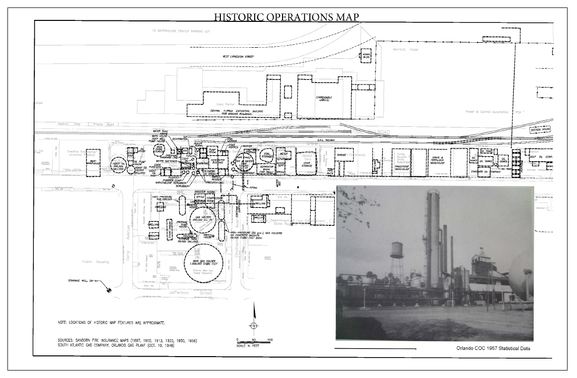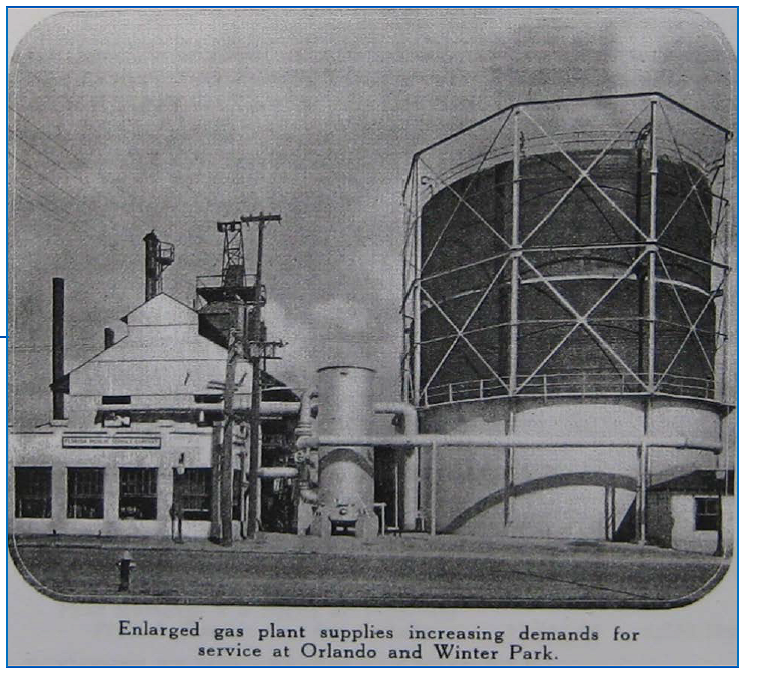History
From approximately 1887 to 1959, a manufactured gas plant was operated on roughly three acres of land on West Robinson Street near Chatham Avenue. This plant was one of more than 3,500 across the country.
Although the plant was considered state-of-the-art at the time, operations came long before knowledge of the potential impacts of contaminants and the implementation of modern environmental regulations. As a result, chemical residues were left at the Plant Site to a degree that would not meet today’s environmental standards. Investigations to address the residuals of the Site are being completed under the authority of the EPA and are supported by the Orlando Gasification Plant Site Group.
Although the plant was considered state-of-the-art at the time, operations came long before knowledge of the potential impacts of contaminants and the implementation of modern environmental regulations. As a result, chemical residues were left at the Plant Site to a degree that would not meet today’s environmental standards. Investigations to address the residuals of the Site are being completed under the authority of the EPA and are supported by the Orlando Gasification Plant Site Group.

Manufactured Gas Plants
Beginning in the 1850s, before natural gas was widely available, gas to heat homes, light streets, fuel industry and for cooking was manufactured from various combustible materials, such as coal, coke or oil. These materials were placed in large ovens and heated to high temperatures in an environment with limited oxygen, producing a form of gas that was distributed throughout the city and used in much the same way as natural gas is used now.
These facilities were known as manufactured gas plants (MGPs) and operations were considered state-of-the-art in their day, generally complying with the regulations that existed at that time. However, few, if any, environmental requirements existed until long after the plants had been shut down.
The last of these plants were shut down in Florida during the early 1960s as natural gas was made available throughout the state.
When the MGPs were shut down, the plant equipment was usually removed, and the demolition debris, along with byproducts that could not be recovered and sold, was usually abandoned in place.
Long after MGPs had ended production, federal and state agencies determined that certain byproducts, including coal tar, pose potential hazards to human health or the environment under certain conditions. State or federal agencies may require that impacts be removed, contained or otherwise addressed when potential hazards to human health or the environment may exist now or in the future.
West Robinson Site (Orlando Gasification Plant Site)
Over the past several years, the Orlando Gasification Plant Site Group has conducted numerous environmental studies and implemented remedial measures at the Site under the direction and guidance of the EPA and the Florida Department of Environmental Protection.
Initial investigations indicated that byproducts of former gas production, such as coal tar, were present in soil and groundwater in the vicinity of the Site. Drinking water for the surrounding communities comes from municipal wells, which are located in a different area and at a significantly greater depth. The Orlando Utilities Commission routinely samples all of its wells and no contaminants from the Site have been found in the municipal drinking water supply.
A Consent Decree for OU1 outlining the portion of the remediation plan that has been approved to-date was executed by the EPA, the U.S. Department of Justice and the Orlando Gasification Plant Site Group, and lodged in the United States District Court, Middle District of Florida Jan. 8, 2015. The Court entered the Consent Decree March 18, 2015. The planning and implementation of the remedy occurred under the direction and guidance of the EPA.
With approval from the EPA, initial construction began in June 2018, concluding six months later in December 2018. Work on the second phase, which began in April 2019 and concluded in March 2020, involved the construction of an underground barrier wall around the Site to ensure impacts cannot migrate.
Construction for OU1 concluded in June 2020, and the operation of an air sparge/soil vapor extraction system and groundwater extraction/treatment/reinjection system is currently underway.
Beginning in the 1850s, before natural gas was widely available, gas to heat homes, light streets, fuel industry and for cooking was manufactured from various combustible materials, such as coal, coke or oil. These materials were placed in large ovens and heated to high temperatures in an environment with limited oxygen, producing a form of gas that was distributed throughout the city and used in much the same way as natural gas is used now.
These facilities were known as manufactured gas plants (MGPs) and operations were considered state-of-the-art in their day, generally complying with the regulations that existed at that time. However, few, if any, environmental requirements existed until long after the plants had been shut down.
The last of these plants were shut down in Florida during the early 1960s as natural gas was made available throughout the state.
When the MGPs were shut down, the plant equipment was usually removed, and the demolition debris, along with byproducts that could not be recovered and sold, was usually abandoned in place.
Long after MGPs had ended production, federal and state agencies determined that certain byproducts, including coal tar, pose potential hazards to human health or the environment under certain conditions. State or federal agencies may require that impacts be removed, contained or otherwise addressed when potential hazards to human health or the environment may exist now or in the future.
West Robinson Site (Orlando Gasification Plant Site)
Over the past several years, the Orlando Gasification Plant Site Group has conducted numerous environmental studies and implemented remedial measures at the Site under the direction and guidance of the EPA and the Florida Department of Environmental Protection.
Initial investigations indicated that byproducts of former gas production, such as coal tar, were present in soil and groundwater in the vicinity of the Site. Drinking water for the surrounding communities comes from municipal wells, which are located in a different area and at a significantly greater depth. The Orlando Utilities Commission routinely samples all of its wells and no contaminants from the Site have been found in the municipal drinking water supply.
A Consent Decree for OU1 outlining the portion of the remediation plan that has been approved to-date was executed by the EPA, the U.S. Department of Justice and the Orlando Gasification Plant Site Group, and lodged in the United States District Court, Middle District of Florida Jan. 8, 2015. The Court entered the Consent Decree March 18, 2015. The planning and implementation of the remedy occurred under the direction and guidance of the EPA.
With approval from the EPA, initial construction began in June 2018, concluding six months later in December 2018. Work on the second phase, which began in April 2019 and concluded in March 2020, involved the construction of an underground barrier wall around the Site to ensure impacts cannot migrate.
Construction for OU1 concluded in June 2020, and the operation of an air sparge/soil vapor extraction system and groundwater extraction/treatment/reinjection system is currently underway.
